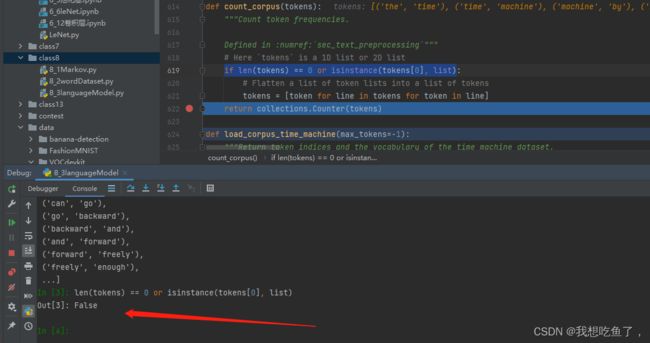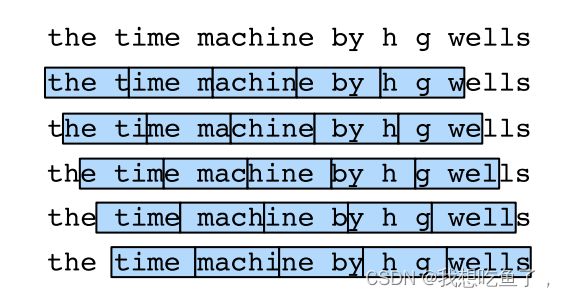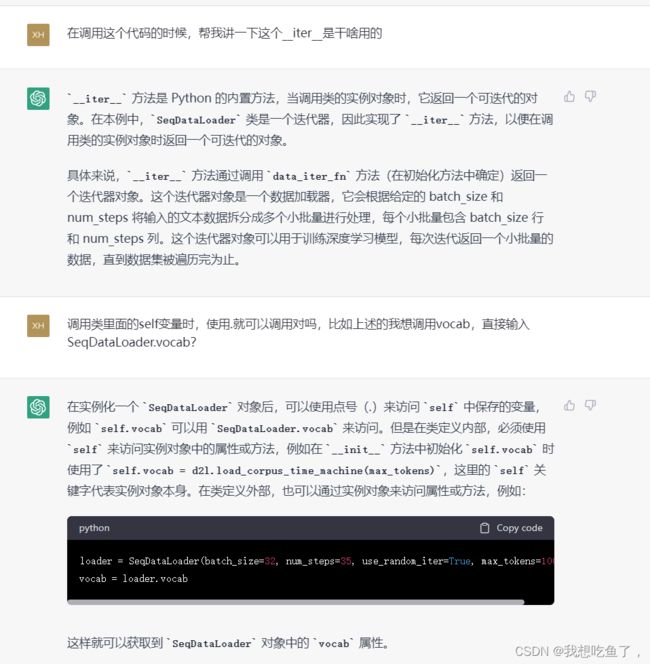d2l语言模型--生成小批量序列
对语言模型的数据集处理做以下汇总与总结
目录
1.k元语法
1.1一元
1.2 二元
1.3 三元
2.随机抽样
2.1各bs之间随机
2.2各bs之间连续
3.封装
1.k元语法
1.1一元
tokens = d2l.tokenize(d2l.read_time_machine())
# 因为每个⽂本⾏不⼀定是⼀个句⼦或⼀个段落,因此我们把所有⽂本⾏拼接到⼀起
corpus = [token for line in tokens for token in line]
vocab = d2l.Vocab(corpus)看看得到了什么:corpus为原txt所有词汇拉成一维list;token_freqs为按1元语法统计的token-freqs列表。
vocab.token_freqs[:10], corpus[:20]
'''
([('the', 2261),
('i', 1267),
('and', 1245),
('of', 1155),
('a', 816),
('to', 695),
('was', 552),
('in', 541),
('that', 443),
('my', 440)],
['the',
'time',
'machine',
'by',
'h',
'g',
'wells',
'i',
'the',
'time',
'traveller',
'for',
'so',
'it',
'will',
'be',
'convenient',
'to',
'speak',
'of'])
'''1.2 二元
二元即为将前后两词连在一起当作一个词元,其token为一个包含tuple的list,其中每个tuple为元txt各2个相邻词组成。
bigram_tokens = [pair for pair in zip(corpus[:-1], corpus[1:])]
bigram_vocab = d2l.Vocab(bigram_tokens)
# 返回
bigram_vocab.token_freqs[:10],bigram_tokens[:5]
'''
([(('of', 'the'), 309),
(('in', 'the'), 169),
(('i', 'had'), 130),
(('i', 'was'), 112),
(('and', 'the'), 109),
(('the', 'time'), 102),
(('it', 'was'), 99),
(('to', 'the'), 85),
(('as', 'i'), 78),
(('of', 'a'), 73)],
[('the', 'time'),
('time', 'machine'),
('machine', 'by'),
('by', 'h'),
('h', 'g')])
'''其中,讲一下相邻2词的实现:
bigram_tokens = [pair for pair in zip(corpus[:-1], corpus[1:])]
bigram_tokens[:5]
'''
[('the', 'time'),
('time', 'machine'),
('machine', 'by'),
('by', 'h'),
('h', 'g')]
'''传入Vocab的tokens为一个list,如果是2维list则会展平成1维;如果本身就为1维则直接对里面的每个元素进行操作
注意,二元语法中传入Vocab的bigram_tokens是如图组成的二元语法,里面每个元素为前后相邻两个字符串为元组的list,在计数的时候不会被拉成1维的list,因为其本身每个需要计数的元素就是bigram_tokens里面的每个元素(二元元组)
1.3 三元
类似的操作:
trigram_tokens = [triple for triple in zip(
corpus[:-2], corpus[1:-1], corpus[2:])]
trigram_vocab = d2l.Vocab(trigram_tokens)
trigram_vocab.token_freqs[:10]
'''
[(('the', 'time', 'traveller'), 59),
(('the', 'time', 'machine'), 30),
(('the', 'medical', 'man'), 24),
(('it', 'seemed', 'to'), 16),
(('it', 'was', 'a'), 15),
...]
'''实现细节:
corpus[-7:], corpus[:-2][-5:], corpus[1:-1][-5:], corpus[2:][-5:]
'''
(['lived', 'on', 'in', 'the', 'heart', 'of', 'man'],
['lived', 'on', 'in', 'the', 'heart'],
['on', 'in', 'the', 'heart', 'of'],
['in', 'the', 'heart', 'of', 'man'])
'''2.随机抽样
任务,给定一个corpus为所有单词拼起来的一维list,输出X,Y,尺寸为(bs,T),实现如下的分割,注意前k个和最后若不足以配T个的就都扔了。
2.1各bs之间随机
def seq_data_iter_random(corpus, batch_size, num_steps): #@save
"""使⽤随机抽样⽣成⼀个⼩批量⼦序列"""
# 从随机偏移量开始对序列进⾏分区,随机范围包括num_steps-1
corpus = corpus[random.randint(0, num_steps - 1):]
# 减去1,是因为我们需要考虑标签
num_subseqs = (len(corpus) - 1) // num_steps
# ⻓度为num_steps的⼦序列的起始索引
initial_indices = list(range(0, num_subseqs * num_steps, num_steps))
# 在随机抽样的迭代过程中,
# 来⾃两个相邻的、随机的、⼩批量中的⼦序列不⼀定在原始序列上相邻
random.shuffle(initial_indices)
def data(pos):
# 返回从pos位置开始的⻓度为num_steps的序列
return corpus[pos: pos + num_steps]
num_batches = num_subseqs // batch_size
for i in range(0, batch_size * num_batches, batch_size):
# 在这⾥,initial_indices包含⼦序列的随机起始索引
initial_indices_per_batch = initial_indices[i: i + batch_size]
X = [data(j) for j in initial_indices_per_batch]
Y = [data(j + 1) for j in initial_indices_per_batch]
yield torch.tensor(X), torch.tensor(Y) num_steps相当于T,表示切分的每个子块中含有多少个词
corpus考虑对前K个,随机切除,前K个就不要了
num_subseqs是看切后的corpus能组成多少个T的块,采用向下取整。在这里为31//5=6
initial_indices计算每个子序列块起始位置的索引
num_batches表示用块的个数除bs,向下取整
for loop 里面i的分割是bs,保证后面取bs个起始位置时不会取重:(见下图例子)
initial_indices_per_batch表示从块起始索引位置list中,抽取bs个起始位置。
my_seq = list(range(35))
for X, Y in seq_data_iter_random(my_seq, batch_size=2, num_steps=5):
print('X: ', X, '\nY:', Y)
'''
X: tensor([[22, 23, 24, 25, 26],
[ 2, 3, 4, 5, 6]])
Y: tensor([[23, 24, 25, 26, 27],
[ 3, 4, 5, 6, 7]])
X: tensor([[17, 18, 19, 20, 21],
[ 7, 8, 9, 10, 11]])
Y: tensor([[18, 19, 20, 21, 22],
[ 8, 9, 10, 11, 12]])
X: tensor([[12, 13, 14, 15, 16],
[27, 28, 29, 30, 31]])
Y: tensor([[13, 14, 15, 16, 17],
[28, 29, 30, 31, 32]])
'''X,Y均为(bs,T).
22预测23;22,23预测24;22,23,24预测25...
2.2各bs之间连续
def seq_data_iter_sequential(corpus, batch_size, num_steps): #@save
"""使⽤顺序分区⽣成⼀个⼩批量⼦序列"""
# 从随机偏移量开始划分序列
offset = random.randint(0, num_steps)
num_tokens = ((len(corpus) - offset - 1) // batch_size) * batch_size
Xs = torch.tensor(corpus[offset: offset + num_tokens])
Ys = torch.tensor(corpus[offset + 1: offset + 1 + num_tokens])
Xs, Ys = Xs.reshape(batch_size, -1), Ys.reshape(batch_size, -1)
num_batches = Xs.shape[1] // num_steps
for i in range(0, num_steps * num_batches, num_steps):
X = Xs[:, i: i + num_steps]
Y = Ys[:, i: i + num_steps]
yield X, Ynum_batches表示能输出几个bs,后面不够bs的都扔掉:
与random一样,核心都是块数//bs,其中块数=cor//num_step(T)
3.封装
class SeqDataLoader: #@save
"""加载序列数据的迭代器"""
def __init__(self, batch_size, num_steps, use_random_iter, max_tokens):
if use_random_iter:
self.data_iter_fn = d2l.seq_data_iter_random
else:
self.data_iter_fn = d2l.seq_data_iter_sequential
self.corpus, self.vocab = d2l.load_corpus_time_machine(max_tokens)
self.batch_size, self.num_steps = batch_size, num_steps
def __iter__(self):
return self.data_iter_fn(self.corpus, self.batch_size, self.num_steps)对于其中的iter:
def load_data_time_machine(batch_size, num_steps, #@save
use_random_iter=False, max_tokens=10000):
"""返回时光机器数据集的迭代器和词表"""
data_iter = SeqDataLoader(
batch_size, num_steps, use_random_iter, max_tokens)
return data_iter, data_iter.vocab




